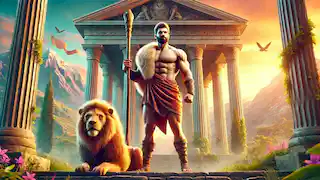Heracles, son of Zeus and Alcmene, is one of the most famous figures of ancient Greek mythology. His story is one of strength, resilience, and redemption. He was known for his immense power and unmatched bravery, but also for his suffering, brought upon by the god Hera's wrath. Hera, the wife of Zeus, never forgave Heracles for being the result of her husband's infidelity, and thus, she sought to make his life as difficult as possible.
The tale of Heracles is most famously marked by the Twelve Labors—a series of nearly impossible tasks he was forced to complete. These trials were his path to redemption after falling into a madness that caused him to commit a terrible crime. Each labor, more challenging than the last, tested his strength, intelligence, and willpower.
This story follows the hero through these legendary tasks, detailing the struggles he faced and the victories he won, not just over fearsome creatures but also within himself. Heracles, beloved by the people of Greece and blessed with extraordinary strength, was not immune to the schemes of the gods. Hera, burning with jealousy, orchestrated his suffering by inflicting him with madness. In his deranged state, Heracles committed a grievous crime, slaughtering his own wife, Megara, and their children. When he returned to his senses and realized what he had done, Heracles was consumed with guilt and sorrow. He sought guidance from the Oracle of Delphi, hoping to find a way to atone for his sins. The Oracle, speaking through the voice of Apollo, commanded him to serve King Eurystheus of Tiryns. Eurystheus, a cowardly and cunning man, despised Heracles and saw an opportunity to rid himself of the mighty hero once and for all. He devised a set of twelve nearly impossible tasks, intending for Heracles to fail and meet his doom. Thus began the Labors of Heracles. Heracles’ first task was to slay the Nemean Lion, a beast that terrorized the land of Nemea. Its golden fur was impervious to any weapon, and it roamed the hills, killing anyone who dared to challenge it. Armed with his bow, a sword, and a club, Heracles ventured into the lion's territory. For days, he tracked the creature through the dense forests and rocky caves. When he finally faced the lion, Heracles realized that his weapons were useless against its impenetrable hide. Thinking quickly, he blocked the entrance to the lion's cave and approached the beast unarmed. With his immense strength, Heracles grappled with the lion and, after a fierce struggle, strangled it to death with his bare hands. He then skinned the lion using its own claws and wore its hide as armor, making himself nearly invincible. Heracles returned to King Eurystheus, presenting the lion’s pelt as proof of his victory. Shocked by the hero’s success, Eurystheus became more fearful and determined to find a way to destroy Heracles. For the second labor, Heracles was sent to kill the Lernaean Hydra, a monstrous serpent with nine heads. Its lair was a poisonous swamp near the town of Lerna. One of the heads was immortal, and whenever one of the other heads was cut off, two more would grow in its place. Heracles approached the creature cautiously, with his nephew Iolaus accompanying him. As the Hydra emerged from its lair, Heracles attacked, swiftly cutting off its heads. However, as soon as one head was severed, two more grew in its place. Realizing he needed a new strategy, Heracles called on Iolaus for help. Iolaus brought a torch and, as Heracles decapitated each head, Iolaus seared the stumps with the flame, preventing the heads from regenerating. Finally, Heracles reached the immortal head. He used a golden sword given to him by Athena to sever it and buried the head under a massive rock. Victorious once again, Heracles dipped his arrows in the Hydra’s venomous blood, making them lethal for any future foes. The third labor seemed, at first, less dangerous than the previous ones. Heracles was tasked with capturing the Ceryneian Hind, a swift and elusive deer sacred to Artemis, goddess of the hunt. The hind had golden antlers and bronze hooves and could outrun any mortal. Heracles knew he had to capture the hind without harming it, for angering Artemis would bring disaster. He spent an entire year chasing the hind through the forests and mountains. Eventually, he managed to trap it by the river Ladon. He carefully bound its legs and prepared to return to Eurystheus. On his way back, Heracles encountered Artemis and her brother, Apollo. Furious that her sacred creature had been captured, Artemis confronted Heracles. However, the hero explained his predicament and promised to release the hind unharmed after presenting it to Eurystheus. Moved by his honesty, Artemis allowed Heracles to continue his journey. Heracles returned to the king with the hind, but true to his word, he set the creature free as soon as it was seen by Eurystheus. Next, Heracles was sent to capture the Erymanthian Boar, a fearsome beast that ravaged the countryside of Mount Erymanthos. The boar was enormous, with tusks sharp enough to tear through armor. Eurystheus believed this wild creature would finally defeat Heracles. Heracles tracked the boar to its den in the snow-covered mountains. He waited patiently for the right moment, and when the boar charged, Heracles trapped it in a deep snowdrift. He then tied the boar with chains and carried it back to Eurystheus. Terrified by the sight of the monstrous creature, Eurystheus hid in a large bronze jar, refusing to come out until the boar was removed. Heracles had once again completed the task, leaving Eurystheus both humiliated and fearful. Heracles’ fifth labor seemed more humiliating than dangerous. Eurystheus ordered him to clean the Augean Stables, home to thousands of cattle belonging to King Augeas. These stables had not been cleaned in over thirty years, and the task appeared impossible. The sheer amount of filth was overwhelming, and Eurystheus was certain that Heracles would fail or refuse such a menial task. However, Heracles devised a clever solution. He diverted the courses of two nearby rivers, the Alpheus and the Peneus, and sent their waters rushing through the stables, washing away the filth in a single day. King Augeas, impressed by Heracles' ingenuity, offered him a reward, but Heracles declined, knowing that Eurystheus would claim the task incomplete if he accepted any compensation. Once again, Heracles triumphed over the impossible, but Eurystheus refused to count this labor, claiming Heracles had cheated by using the rivers. Nonetheless, Heracles moved forward to the next challenge. Heracles' sixth labor took him to the marshes of Stymphalus, where a flock of deadly birds terrorized the local population. These birds had beaks of bronze and sharp metallic feathers, which they could launch at their victims. Their presence in the marshes made it impossible for anyone to travel safely in the region. To drive the birds away, Heracles used a set of bronze castanets given to him by Athena. He climbed to a high point near the marshes and began clashing the castanets together, creating a deafening sound. The birds, frightened by the noise, took to the sky in panic. Heracles then shot them down with his poisoned arrows, clearing the marshes and restoring peace to the region. Heracles’ seventh labor took him across the sea to the island of Crete. King Minos, ruler of Crete, had been cursed by the gods with a powerful and destructive bull. The Cretan Bull had once been a gift from Poseidon, but when Minos failed to sacrifice it as promised, the god drove the bull into a frenzy. It rampaged across the island, destroying crops and villages. Heracles arrived on Crete and confronted the bull. Using his immense strength, he wrestled the creature to the ground, binding its legs and leading it back to King Eurystheus. The king was again astonished by Heracles’ success. However, he was too frightened to keep the bull and released it, allowing the creature to wander freely until it was eventually slain by Theseus. For the eighth labor, Heracles was ordered to capture the Mares of Diomedes, four wild horses that fed on human flesh. These savage beasts belonged to Diomedes, the king of Thrace, who delighted in feeding them the bodies of his enemies. Heracles journeyed to Thrace with a small band of companions. Upon reaching Diomedes’ stronghold, he and his men fought off the king’s soldiers and seized the horses. Heracles soon discovered that the only way to subdue the mares was to feed them their own master . He overpowered Diomedes and fed him to the beasts, calming their wild nature. Heracles then led the horses back to Eurystheus, who was horrified by their bloodthirsty appearance. He ordered the mares to be released, and they eventually roamed the wilds of Mount Olympus, where they were killed by wild animals. Heracles’ ninth labor took him to the land of the Amazons, a fierce race of warrior women. Eurystheus’ daughter had requested the belt of Hippolyta, the queen of the Amazons, as a gift, and Heracles was tasked with retrieving it. Heracles sailed to the land of the Amazons and was greeted warmly by Hippolyta, who admired his strength and bravery. She agreed to give him the belt willingly. However, Hera, still determined to make Heracles suffer, disguised herself as an Amazon warrior and spread rumors that Heracles was planning to kidnap their queen. The Amazons, believing the lie, attacked Heracles. A fierce battle ensued, and despite his reluctance to fight the warrior women, Heracles was forced to defend himself. In the chaos, Hippolyta was killed. Grieving for her death, Heracles took the belt and returned to Eurystheus, completing yet another labor. For his tenth labor, Heracles was sent to the far reaches of the western world, beyond the known lands, to retrieve the cattle of Geryon. Geryon was a fearsome giant with three bodies and three heads, and his cattle were guarded by a two-headed dog named Orthrus and a herdsman named Eurytion. Heracles traveled to the island of Erytheia, where he encountered Orthrus. With a single blow from his club, Heracles killed the monstrous dog. He then fought and killed Eurytion before finally confronting Geryon. The battle was fierce, but Heracles, armed with his poisoned arrows and his unmatched strength, was able to slay the giant. Heracles gathered the cattle and began the long journey back to Greece. On the way, he faced numerous challenges, including the theft of some of the cattle by a king named Eryx. Heracles fought and defeated Eryx, eventually delivering the cattle to Eurystheus, who sacrificed them to Hera. The eleventh labor took Heracles on another journey to the edge of the world, this time to retrieve the golden apples of the Hesperides. These apples, which granted immortality, were guarded by the Hesperides, nymphs of the evening, and a hundred-headed dragon named Ladon. Unsure of where to find the apples, Heracles sought advice from the Old Man of the Sea, Nereus. After wrestling Nereus into submission, the sea god revealed the location of the garden. Heracles made his way to the garden and encountered the titan Atlas, who held up the sky on his shoulders. Heracles asked Atlas to retrieve the apples while he temporarily took the titan’s burden. Atlas agreed and returned with the apples, but he attempted to trick Heracles into holding the sky permanently. Heracles, however, outwitted the titan by asking him to briefly take the sky back while he adjusted his cloak. Once Atlas was holding the sky again, Heracles took the apples and left. The final labor was the most dangerous of all. Heracles was tasked with capturing Cerberus, the three-headed guard dog of the underworld. This required Heracles to journey into the realm of Hades, a place no living mortal could enter and return from. Heracles sought the help of Hermes, the messenger god, and Athena, the goddess of wisdom. They guided him to the entrance of the underworld, where he was allowed to pass through the gates by Hades himself, on the condition that he could capture Cerberus without using weapons. Heracles confronted the monstrous hound and, with his great strength, wrestled Cerberus into submission. He carried the fearsome creature back to Eurystheus, who was so terrified at the sight of Cerberus that he begged Heracles to return it to the underworld immediately. Heracles complied, completing his final labor. With the completion of the Twelve Labors, Heracles had atoned for the crime of killing his family. He had faced impossible challenges, conquered terrifying monsters, and emerged as a symbol of strength and perseverance. His legend lived on, inspiring countless stories, songs, and plays, making him one of the greatest heroes in Greek mythology. The Labors of Heracles were not just a test of his physical strength, but also of his character, intelligence, and resilience. Though the gods often sought to undermine him, Heracles' will and determination proved unbreakable.The Madness of Heracles
The First Labor - The Nemean Lion
The Second Labor - The Lernaean Hydra
The Third Labor - The Ceryneian Hind
The Fourth Labor - The Erymanthian Boar
The Fifth Labor - The Augean Stables
The Sixth Labor - The Stymphalian Birds
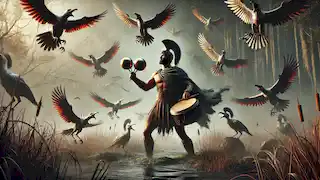
The Seventh Labor - The Cretan Bull
The Eighth Labor - The Mares of Diomedes
The Ninth Labor - The Belt of Hippolyta
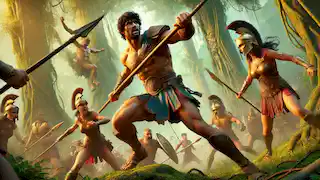
The Tenth Labor - The Cattle of Geryon
The Eleventh Labor - The Apples of the Hesperides
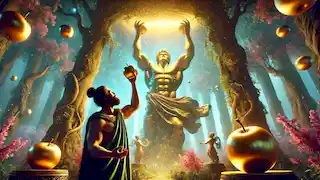
The Twelfth Labor - The Capture of Cerberus
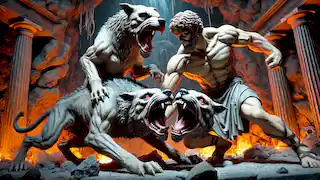
Conclusion
